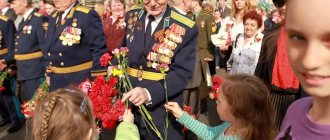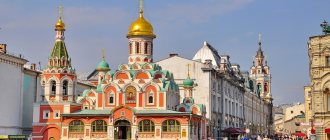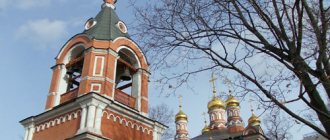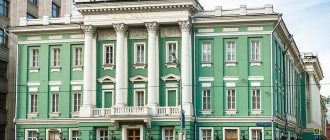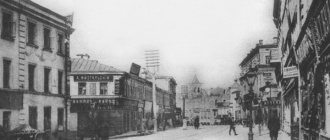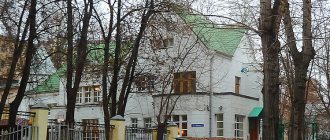Kutuzovskaya Izba in Fili: “...I will sacrifice myself and for the good of the Fatherland I order to retreat”
Nowadays, Fili is one of the most expensive and dynamically developing areas of Moscow. Along Kutuzovsky Prospekt and Bolshaya Dorogomilovskaya Street, lined with magnificent Stalinist buildings, an endless stream of cars moves day and night. Moscow City skyscrapers rise nearby. Victory Park is located on Poklonnaya Hill.
Exit from Bolshaya Dorogomilovskaya Street to Kutuzovsky Prospekt
Among this bustle, behind the building of the Borodino panorama, a modest wooden house is hidden - “Kutuzovskaya Izba in Fili” . On September 1 (13), 1812, a fateful military council took place here, which largely predetermined the outcome of the war with Napoleon.
- Tell me, uncle, it’s not for nothing that Moscow, burned by fire, was given to the Frenchman? After all, there were fighting fights, Yes, they say, some more! No wonder all of Russia remembers Borodin Day!
- Yes, there were people in our time, Not like the current tribe: The heroes are not you! They had a bad lot: Few returned from the field... If it weren’t for the Lord’s will, they wouldn’t have given up Moscow!
— M.Yu. Lermontov. "Borodino"
Kutuzovskaya hut in Fili
***
The Patriotic War began on June 12 (24), 1812. The loss of Smolensk opened the way for Napoleonic troops to Moscow.
"The Battle of Smolensk on August 17, 1812." J.-S. Langlois, 1839
The bloody Battle of Borodino only delayed the enemy, but did not stop him. The Russian army lost, according to various estimates, from 40 to 50 thousand people, more than 40 generals were killed, wounded or captured. French losses were comparable: from 30 to 40 thousand (possibly more) total losses, among them 42 generals.
The Battle of Borodino was the most beautiful and most formidable, the French showed themselves worthy of victory, and the Russians deserved to be invincible.
— Napoleon
"Battle of Borodino". L.-F. Lejeune, 1822
Russian troops were forced to retreat to Poklonnaya Hill near Moscow. Barclay de Tolly, having carried out reconnaissance, came to the conclusion that the hilly terrain, indented by ravines and rivers, did not provide a chance for a successful outcome of the battle for the tired and noticeably thinned army after the Battle of Borodino.
***
The deep valley of the Setun River divides Poklonnaya Mountain into two parts. In its western part (171.5 meters above sea level) Victory Park is now located. The eastern part (166.6 meters) was demolished in the 1950-1960s during the construction of Kutuzovsky Avenue and residential areas. In the 19th century these were the outskirts of Moscow. From the height there was a view of the city lying several miles ahead. Important guests were greeted on Poklonnaya Hill, travelers bowed to Moscow and its shrines. This is probably why it got its name.
The village of Fili (formerly Khvili), known since 1454, was originally located at a distance from the Smolensk road, 4 versts from the Dorogomilovskaya outpost. It owes its name to the Filka River. In 1689, Peter I granted Khvili and nearby villages as the patrimony of his uncle, boyar Lev Kirillovich Naryshkin, the brother of Tsarina Natalya Kirillovna. The magnificent estate church of the Intercession of the Blessed Virgin Mary in Fili, built in 1690-1694 in the “Naryshkin Baroque” style, has survived to this day. Around 1704, Naryshkin ordered the peasant households to be moved away from the master's estate - to the Mozhaisk road near Poklonnaya Gora.
Church of the Intercession of the Blessed Virgin Mary in Fili
The largest house in the village of Fili belonged to the Frolov family, numbering 16 people. It was inhabited by Mikhail Frolov, his wife Pelageya, nee Petrova, three adult sons - Maxim, Ivan and Mikhail with their families and daughter Akulina. It was here that a military council took place under the leadership of Field Marshal Mikhail Illarionovich Kutuzov.
"Kutuzovskaya hut in Fili." A.K.Savrasov, 1860s
The exact number of participants is unknown, since no protocol was kept. According to eyewitnesses, in addition to Kutuzov, generals M.B. Barclay de Tolly, L.L. Bennigsen, D.S. Dokhturov, A.P. Ermolov, P.P. Konovnitsyn, A.I. Osterman were present there. Tolstoy, N.N. Raevsky, K.F. Tol, F.P. Uvarov and General P.S. Kaisarov, who was on duty that day. Perhaps M.I. Platov was also there, who was in a very difficult relationship with Kutuzov.
"Military Council in Fili." A.D. Kivshenko, 1880
Barclay de Tolly outlined the current situation and proposed retreating in order to save the army.
By saving Moscow, Russia is not being saved from war, which is cruel and ruinous. But having saved the army, the hopes of the Fatherland are not yet destroyed, and the war... can continue with convenience: the troops being prepared will have time to join in different places outside Moscow.
— M.B. Barclay de Tolly
Opinions were divided. Bennigsen and Ermolov, Konovnitsyn, Uvarov and Dokhturov, who supported him, advocated a new battle, believing that retreat would make the victims of the Battle of Borodino meaningless, undermine the morale of the soldiers and bring ruin to the local residents. Osterman-Tolstoy, Raevsky and Tol supported Barclay de Tolly. Kutuzov added: “The French army will dissolve in Moscow like a sponge in water.” Taking full responsibility upon himself, the field marshal made a difficult decision: to leave Moscow and retreat along the Ryazan road.
With the loss of Moscow, Russia is not yet lost; my main task is the preservation of the army. I order you to retreat.
— M.I.Kutuzov
How this decision would be received by the court was unknown. The army, having received the order to retreat, grumbled. Moscow authorities and citizens were at a loss. At night after the council, the commander-in-chief of the Russian army walked from corner to corner for a long time and did not sleep well. He threatened: “Well, I’ll bring the damned French... they will eat horse meat.”
***
...Napoleon waited in vain, intoxicated with his last happiness, for Moscow on its knees with the keys of the old Kremlin...
- A.S. Pushkin. "Eugene Onegin"
“Before Moscow. Waiting for the deputation of the boyars. Napoleon on Poklonnaya Hill". V.V.Vereshchagin, 1891-1892
On September 2 (14), 1812, Napoleon, without waiting for the symbolic keys to Moscow on Poklonnaya Hill, entered the empty city and headed to the Kremlin.
In the Kremlin, just like in most private mansions, everything was in place: even the clock ticked, as if the owners remained at home. The city without inhabitants was enveloped in gloomy silence. During our entire long journey we did not meet a single local resident; the army took up positions in the surrounding area; some corps were housed in barracks. At three o'clock the emperor mounted his horse, rode around the Kremlin, was in the Orphanage, visited two important bridges and returned to the Kremlin, where he settled in the state chambers of Emperor Alexander.
— Master of the Horse Armand de Caulaincourt
The entry of the French into Moscow. French splint
On the same day, fires started in different places in Moscow. At night and the next day, the wind increased significantly, and the flames flared up with unprecedented force. The heat was so unbearable that on the morning of September 4, Napoleon was forced to leave the Kremlin and move to the Petrovsky Travel Palace located in the suburbs. However, the heat from the Moscow fire was felt there too: it was impossible to approach the windows.
We were surrounded by a sea of flames; it threatened all the gates leading from the Kremlin. The first attempts to get out of it were unsuccessful. Finally, an exit to the Moscow River was found under the mountain. Napoleon left the Kremlin through it with his retinue and the old guard. Approaching closer to the fire, we did not dare to enter these waves of the fiery sea. Those who managed to become somewhat familiar with the city did not recognize the streets that disappeared in smoke and ruins. However, it was necessary to decide on something, since with every moment the fire intensified more and more around us. The intense heat burned our eyes, but we could not close them and had to look forward. The suffocating air, hot ash and flames escaping from everywhere spiraled our breath, short, dry, constricted and suppressed by smoke. We burned our hands, trying to protect our faces from the terrible heat, and threw off the sparks that showered and burned through our dress.
— Count Segur
"Fire of Moscow". A.F. Smirnov, 1810s
The fiery hell continued until September 6. More than 400 lower-class townspeople accused of arson were shot. Napoleon returned to the Kremlin. Three times he sent a peace proposal to Emperor Alexander I. The answer was silence... Meanwhile, Napoleonic army was engaged in looting. Houses and estates were looted, temples were desecrated, and monasteries were destroyed. The French did not spare the Moscow region either.
“Execution of alleged Moscow arsonists by the French.” V.V.Vereshchagin, 1898
It was dangerous to remain in a devastated city without food supplies in the conditions of the approaching winter. On October 7 (19), Napoleonic army advanced from Moscow along the Old Kaluga Road. The order was given to blow up the Kremlin, but the ancient fortress was only partially damaged.
"Napoleon's Retreat from Moscow." Adolf Northen, mid-19th century
After the French left, crowds of peasants poured into Moscow with bad intentions.
We entered Moscow on the evening of the 11th. The city was given over to the plunder of the peasants, of whom a great multitude flocked, all of them drunk; The Cossacks and their elders completed the rout. Entering the city with the hussars and Life Cossacks, I considered it my duty to immediately take command of the police units of the unfortunate capital: people were killing each other in the streets, setting houses on fire. Finally everything calmed down and the fire was put out. I had to fight some real battles.
— Benkendorf to Count M.S. Vorontsov
There will still be difficult battles ahead at Maloyaroslavets on October 12 (24), at Vyazma on October 22 (November 3), on the Berezina on November 14 (26)-17 (29) and many others. Napoleon’s plans to spend the winter somewhere between “Smolensk, Mogilev, Minsk and Vitebsk” and the next year to again embark on “a new campaign, the action of which I will direct to St. Petersburg or Kyiv” were not destined to come true.
"The retreat of the French through the Berezina on November 17 (29), 1812." Peter von Hess, 1844
In January 1813, the Russian army set out on a foreign campaign. On October 16-19, 1813, Napoleon was defeated in the “Battle of the Nations” near Leipzig. On March 31, 1814, coalition troops entered Paris. April 6, 1814 Napoleon Bonaparte abdicated the throne.
"The war of the Russian people against the French." Caricature by J. Cruikshank, 1813
Kutuzov’s calculation turned out to be correct: “with the loss of Moscow, Russia is not lost yet.” In Russia, Napoleon's losses amounted to about 580 thousand soldiers killed, wounded, prisoners and deserters, as well as almost all horses. From the Great Army, from 10 to 30 thousand people remained alive, from the 47 thousand guard - several hundred. The total losses of the Russian army amounted to about 500 thousand people, of which 150 to 200 thousand people were killed.
The size of the Napoleonic army when moving into Russia (beige stripe) and back (black stripe). Below is the air temperature on the Reaumur scale when the army left Moscow. Infographics by Charles Minard, 19th century
***
In April 1813, 67-year-old Kutuzov caught a cold. On April 16 (28), 1813, he died in the Silesian town of Bunzlau (Prussia, now the city of Boleslawiec in Poland). The embalmed body was sent to Russia, where on June 13 (25), 1813, the field marshal was buried in the Kazan Cathedral in St. Petersburg. The internal organs remaining after embalming were buried in the village of Tillendorf, three kilometers from Bunzlau. According to legend, Kutuzov’s heart was also buried there, but this contradicts the Orthodox tradition. When the crypt was opened in 1933, in the coffin with the remains they found, as expected, a silver vessel with the embalmed heart of the famous commander.
Funeral of M.I. Kutuzov. Engraving by M.N. Vorobyov, 1814
***
Mikhail Frolov died in 1813. His son Mikhail, the last witness of the military council, died in 1846. In 1854, the owner of the village of Fili, E.D. Naryshkin, again resettled the peasants from Fili to Pokrovskoye. The houses were dismantled and transported to a new location. At the request of local residents and history buffs, the Kutuzov Izba remained in its original location and was turned into a museum. A retired disabled soldier was settled in it and looked after the property.
"Kutuzovskaya hut in Fili." A.K.Savrasov, 1884
However, in 1867, the caretaker was evicted, some of the things were taken away, and the house was boarded up. On June 7 (19), 1868, the Kutuzov hut and furniture burned down. Fortunately, the artist A.K. Savrasov managed to capture it in his paintings.
In 1883, the Society of Officers of the Grenadier Corps erected a memorial obelisk - a stone road pillar from the Smolensk road. There are two memorial plaques attached to it. One - with the final words of M.I. Kutuzov at the military council:
At the council, the field marshal said that “with the loss of Moscow, Russia is not yet lost. I make it my duty to preserve the army, to get closer to reinforcements, and by the very concession of Moscow to prepare the enemy’s inevitable death, and therefore I intend, having passed Moscow, to retreat along the Ryazan road.” He ended the advice like this: “I will have to pay for everything; I will sacrifice myself and for the good of the fatherland I order to retreat.”
The second tablet tells about the history of the Kutuzov hut:
In this place there was a hut that belonged to the peasant of the village of Fili, Frolov, where on September 1, 1812 there was a military council chaired by Field Marshal Kutuzov, who decided the fate of Moscow and the salvation of Russia. The hut burned down on June 7, 1868. The officers of the Grenadier Corps, who were on a military excursion in 1883 in the vicinity of Moscow, were imbued with reverence for the historical place, and had the desire to immortalize this place with stone and surround it with a fence, which was filled with the care and zeal of the Grenadier officials corps on November 8, 1883.
Memorial obelisk in front of the Kutuzovskaya Izba, erected by the Society of Grenadier Corps Officers
In 1886, on the initiative and with funds from the Society of Banner Bearers of the Cathedral of Christ the Savior, the Kutuzovskaya Izba was recreated with some changes. On August 3, 1887, its consecration took place. Inside there was a museum and a shelter for 4 disabled people. Nowadays, the Kutuzov Izba, the Battle of Borodino Panorama Museum and the Triumphal Arch are part of the historical and memorial complex of the Patriotic War of 1812 .
Kutuzovskaya hut
Kutuzovskaya hut
Bricks with marks at the base of the Kutuzov Izba
Shutters
Mounting on shutters
Spring
You can visit the hut only with a guided tour. First, the guide talks about the history of the hut and the events of the War of 1812, and then visitors are treated to an unusual multimedia show: the shutters open and what is revealed before your eyes is not a noisy Moscow quarter, but an autumn field where Russian soldiers are training. One of them looks into the room... After this, the tour moves outside, and then back into the house, into the second room, where you can see old cartoons dedicated to the Patriotic War of 1812.
Kutuzov, immersed in heavy thoughts, after the military council
Autumn field
Antique chest and household utensils
Second exhibition hall
Stylized Russian stove
In 1911, with funds from the Moscow Society of Banner Bearers of the Cathedral of Christ the Savior, a temple-chapel of the Archangel Michael was erected at the Kutuzov Izba in Fili . Archangel Michael is considered the heavenly patron of the Russian army and Field Marshal Kutuzov. On August 16, 1912, on the 100th anniversary of the Battle of Smolensk, the first Kutuzov museum . The chapel, assigned to the Church of the Intercession in Fili, was consecrated on September 9, 1912.
Temple of Michael the Archangel
Some things from the Kutuzov hut were transferred to the Kutuzov Museum; personal belongings of the field marshal, samples of uniforms and weapons from the Patriotic War of 1812 were kept. “Patriotic readings for youth” were held in a special hall. In 1930, the Kutuzov chapel and museum were closed. The building first housed a canteen, then it was replaced by a workers' club, one of the premises of the USSR Ministry of Finance, and during Perestroika - a commercial enterprise. In 1994, the chapel was returned to the Moscow Patriarchate. Nowadays it is assigned to the Church of the Great Martyr George the Victorious on Poklonnaya Hill.
Bust of Kutuzov and the Temple of Michael the Archangel
Next to the Kutuzovskaya hut is the Coach House , built by the banner bearers of the Cathedral of Christ the Savior for the “cart of Kutuzov”. It was presented to the Kutuzov Museum by the huntsman of the highest court, Pavel Pavlovich Golenishchev-Kutuzov-Tolstoy. On it, in August 1812, the field marshal arrived in the active army and rode around the battlefields. In 1929, Kutuzov’s traveling carriage was transferred to the Borodino Field Museum-Reserve, where it is still kept. The rebuilt Carriage Barn housed the service premises of the Kutuzovskaya Izba museum.
Former Coach House
Between the Kutuzovskaya Izba and the Carriage Barn there is another old milestone from the Smolensk road.
Milestone “2 versts from Moscow”
A little further away there is a memorial obelisk from the grave of soldiers who died in the Battle of Borodino . The obelisk was installed at the Dorogomilovsky cemetery over the common grave of soldiers who died of wounds after the Battle of Borodino. The inscription on it read: “This monument was erected over the common grave of 300 suffering soldiers who were wounded in the Battle of Borodino and died on the way to Moscow. Eternal memory to you, martyrs, sufferers, soldiers of Christ, who laid down their lives for the faith, the Tsar and the Fatherland.” After the October Revolution, the old obelisk was destroyed as not corresponding to the new ideology; in 1940, a new one was erected in its place.
Obelisk from the grave of soldiers who died in the Battle of Borodino
Obelisk from the grave of soldiers who died in the Battle of Borodino
The Dorogomilovskoe cemetery appeared in 1771, when the plague epidemic swept through Moscow. In 1948, it and the adjacent Jewish cemetery were closed, the cemetery church of St. Elizabeth and burials were destroyed, and the vacant space was built up with prestigious Stalinist houses. Now here are the 17th, 18th and 19th blocks of Dorogomilov, part of the Taras Shevchenko embankment, a green zone and a business area. After the destruction of the cemetery, the obelisk was moved to the Kutuzov hut, and the remains of the soldiers remained lying in the ground in the same place.
The remains of the Dorogomilovsky cemetery and the Obelisk to the soldiers who died in the Battle of Borodino, photo from the early 1950s
Near the Borodino panorama there is a monument to M.I. Kutuzov , erected in 1973. Sculptor N.V. Tomsky, architect L.G. Golubovsky. The project for a monument to the great field marshal arose back in 1912, when the Committee of Zealots of the Memory of the Patriotic War began collecting funds for its installation. However, there was not enough money, then the revolution broke out. The idea of the monument was returned to in 1945, a special decree of Stalin was signed. But the death of Stalin and the fight against the cult of personality again postponed the construction of the monument.
The commander is depicted riding a horse, the prototype of which was Semyon Budyonny’s stallion Sophist. The high reliefs on the base of the pedestal depict officers and comrades of Kutuzov, soldiers, militias and partisans.
Monument to M.I. Kutuzov near the Borodino panorama
***
- Address of the Kutuzovskaya Izba Museum : Moscow, Kutuzovsky Prospekt, 38, building 2
- Opening hours : from 10:00 to 18:00, Thursday: 10:00 to 21:00, closed Friday and last Thursday of each month.
- A visit to the museum is made as part of an excursion group at the following sessions: 10:00, 11:00, 12:00, 13:00, 14:00, 15:00, 16:00, 17:00; on Thursdays there are additional sessions at 18:00 and 19:00.
- Phones, +7 (499) 148-61-90,
- Ticket price : adult - 200 rubles, reduced price - 100 rubles, photography is free.
- On Monday of the 3rd week of each month, admission to the museum is free.
- The Battle of Borodino Panorama Museum is closed for major renovations. Completion of work is scheduled for the third quarter of 2019.
Scheme of the museum-historical complex of the Patriotic War of 1812
© Website “On the Roads of the Middle Way”, 2009-2021. Copying and reprinting of any materials and photographs from the site anashina.com in electronic publications and printed publications is prohibited.
Online services that help me travel:
- Cheap flights: Aviasales
- Hotels and recreation centers: Booking
- Travel insurance: Cherehapa
- Excursions in Russian: Tripster and Sputnik8
View all
Exposition Kutuzovskaya Izba
See all photos (4)
- Add a photo
- Add an article
- Add a comment
Panorama "Battle of Borodino"
One of the largest paintings in the world - 115 m long and 15 m high - is a panorama of the Battle of Borodino, created by the Russian artist of French origin Franz Roubaud in Munich.
6.03.12/Added by the editors/
- Show object on map
- Show similar properties
- Opening hours: Sat-Thu: 10.00-18.00
- Object page on the Internet: https://1812panorama.ru
- contact number
- Address: Kutuzovsky prospect, 38, building 2
- Coordinates: 37°31′23.24″E; 55°44′22.74″N
Print information about an object
The exhibition “Kutuzovskaya Izba” is a branch of the Panorama Museum “Battle of Borodino”.
In 1812, after the Battle of Borodino, Russian troops retreated to the Dorogomilovskaya outpost. The headquarters was located in the village of Fili in the hut of the peasant Mikhail Frolov.
It was here that the famous council took place in Fili, at which it was decided: to accept a new battle or give up Moscow, retaining the main forces. It was here that the famous phrase of Mikhail Kutuzov was heard: “With the loss of Moscow, Russia is not yet lost, I set my main task to preserve the army.”
The famous hut of the peasant Frolov burned down on June 7, 1868, along with most of the furnishings. In its place, on November 8, 1883, through the diligence of the officers of the Grenadier Corps, a monument was erected. The hut itself was restored in 1887. Today there is an exhibition dedicated to the events of the Patriotic War of 1812.
The exhibition space of the museum consists of three parts: in the entryway there are portraits of members of the Council in Fili, copies of paintings by A.D. Kivshenko “Military Council in Fili” and A.K. Savrasov “Kutuzovskaya Izba”.
In the upper room, the furnishings of the council of 1812 have been restored: a table, a bench, a Russian stove, icons, peasant utensils, and there are also portraits of council members, stands with historical books dedicated to the theme “Military Council in Fili.” In the same room there are things found on the Borodino field: a pectoral cross, buckshot, etc.
The third room is entirely dedicated to the life and military activities of M.I. Kutuzova. Here are his portraits and portraits of his family members, personal belongings. In the same room there are samples of uniforms and weapons.
In 1995, the Kutuzovskaya Izba was closed for an indefinite period. It opened only at the beginning of 2012.
Book a tour of this site
I have not been hereI have been hereMy notes on visiting this site
Add to visit planAdded to visit planMy visit plan
Military Council in Fili. Alexey Kivshenko
Barclay de Tolly was the first to substantiate the point of view about the need in the current situation to abandon the city to save the army and the victorious outcome of the campaign. His main opponent was Bennigsen, who insisted on holding a battle to protect the capital of the capital in order to avoid a negative moral impact on the army and society as a whole. Among the generals, the idea of a counter-attack movement against Napoleon's army was also expressed, but, after the criticism expressed, it did not receive support. As a result of the roll call vote on the first two proposals, the opinions of council members were divided approximately equally. The final and difficult decision was made by Kutuzov. He ordered to leave the city and save the army for future hostilities, because, in his words, “Russia is not lost with the loss of Moscow.” The next day, September 2, 1812, Russian troops, having passed the city, left the capital, retreating along the Ryazan road, and later, having completed the Tarutino march-maneuver, broke away from the enemy.
The military council in Fili was described by L.N. Tolstoy in the novel “War and Peace”; according to this description, the famous picture was painted, which was included in school textbooks.
Reproducing a historical event on his canvas, Alexey Kivshenko (1851–1895) closely followed the writer. Just as in the novel, the characters are located at the table; the granddaughter of the owner of the hut climbed onto the stove. We see here M. I. Kutuzov, P. S. Kaisarov, P. P. Konovnitsyn, N. N. Raevsky, A. I. Osterman-Tolstoy, M. B. Barclay de Tolly, F. P. Uvarov, D. S. Dokhturov, A. P. Ermolov, K. Tolya and L. L. Bennigsen. All the characters are not only similar in portraiture, but the artist managed to convey their state of mind and show everyone’s attitude to what is happening. And that’s to say: the fate of Russia is being decided. Leave Moscow or accept the battle? And Kutuzov’s famous line is about to be heard: “With the loss of Moscow, Russia is not yet lost.” Kivshenko’s biographer V. G. Kazantsev wrote that the “Military Council” interested the artist “not with its shiny uniforms, not with the lighting effect, but precisely with the desire to reproduce in paint the facial expressions of the participants in this great drama, which played out in such a modest setting <...> the grandeur and deep meaning of the moment being experienced.” It is not for nothing that this painting, as mentioned above, has become a textbook - not a single publication or exhibition dedicated to the Patriotic War of 1812 could do without it. “The painting, <...> distributed throughout Russia in thousands of reproductions, immediately promoted Alexei Danilovich among historical artists and made his name known in Russia, and then abroad.” Written by November 1879, it earned the author the right to a retirement trip, was repeated for the gallery of P. M. Tretyakov (1882) and made a splash at the Berlin Exhibition (1886).
